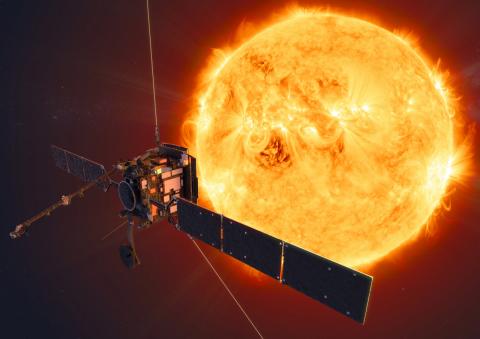
Solar Orbiter heads for the sun! Its mission is to explore the heliosphere
On 10 February 2020, Europe’s Solar Orbiter probe left Earth from Florida (United States) heading for the Sun’s poles. Its mission? To find out about our star’s solar winds, activity and cycles in order to better understand its eruptive phenomena and how it influences its environment. French research has made a strong contribution to this venture, which has involved scientists from Université Paris-Saclay.
Solar Orbiter satellite is the size of a van with a 209 kg payload. Launched on 10th February aboard an Atlas V 411 rocket provided by NASA, it has left on a mission to explore and study the Sun over a period of seven to ten years. It will focus in particular on the heliosphere - a kind of bubble created by the solar winds which contains the entire solar system and separates it from interstellar space.
The satellite will be kept busy throughout this period. On board are ten instruments, many of which have been supplied by Université Paris-Saclay’s laboratories, and which combine in situ measurements (as close as possible to the probe) and remote-sensing measurements. Four of them will measure the plasma and magnetic field of the solar winds, and six will analyse the light emitted by the Sun and take pictures of the star.
Solar winds are released from the upper atmosphere of the Sun and form a plasma - a state of matter where ions and electrons move independently. These winds “can be slow or fast. It is not known what causes this variationˮ, says researcher Miho Janvier, from l'Institut d'astrophysique spatiale (The Institute of Space Astrophysics) (IAS – Université Paris-Saclay, CNRS), which is taking part in the mission. The winds are sometimes disrupted by solar flares which eject a cloud of charged particles into a magnetic field, causing solar storms of variable intensity. In extreme cases, these storms affect technological devices on Earth such as GPS.
“Is it the same wind which varies continually from one solar region to another, or are there different sources of wind?ˮ the researcher continues. This is one of the mysteries that scientists are hoping to solve during this mission. “With Solar Orbiter, we can study the same phenomenon from two different distances. It is just like understanding the flow of a river by returning to its source and observing the currents, waterfalls and eddies which then explain what we see further downstream.ˮ
Solar Orbiter will use the gravity of Venus and the Earth to complete its two-year journey to the Sun. This trajectory will allow it to take the very first images of the Sun from inside Mercury's orbit, at a distance which is less than a third of the distance between the Earth and the Sun!
Instruments developed in Université Paris-Saclay’s laboratories
Laboratories at Université Paris-Saclay have been engaged right from the start of the project in 2012 in making some of the instruments on board the satellite. L’Institut d'astrophysique spatiale (the Institute of Space Astrophysics) (IAS - Université Paris-Saclay, CNRS) is responsible for the operation of the SPICE spectrometer. This instrument records the density, temperature, velocity and chemical composition of the solar atmosphere. IAS is also the lead research body for the PHI - an instrument which will measure the magnetic field and radial velocities on the Sun's surface and probe its interior using time-distance helioseismology. Finally, the Institute is scientifically jointly responsible for the EUI instrument. This is an extreme ultraviolet imaging telescope which will provide image sequences of the solar atmospheric layers from the photosphere to the corona. For this instrument, the Charles Fabry Laboratory (LCF - Université Paris-Saclay, Institut d'Optique Graduate School, CNRS) made the mirrors for the HRI (High Resolution Imager) and FSI (Full Sun Imager) extreme ultraviolet telescopes.
L’Institut de recherche sur les lois fondamentales de l’Univers (The Institute for Research on the Fundamental Laws of the Universe) (IRFU – Université Paris- Saclay, CEA) has designed and built the focal plane sensors on the STIX instrument. This is a telescope which will take images and spectra of solar flares as X-rays.
Le Laboratoire de physique des plasmas (The Plasma Physics Laboratory) (LPP - Université Paris-Saclay, CNRS, École polytechnique) designed and built the measuring head for the SWA's ion sensor. This solar wind analyser will comprehensively analyse the main constituents of the solar wind plasma using three sensors (protons, electrons and ions). The LPP also helped develop the RPW instrument, which will measure magnetic and electric fields using a high temporal resolution to determine the characteristics of electromagnetic and electrostatic waves in the solar wind.
“We have theories, but there are still many pieces of the puzzle missing,ˮ says Miho Janvier (IAS). With the launch of the Solar Orbiter, these mysteries should soon be solved!
